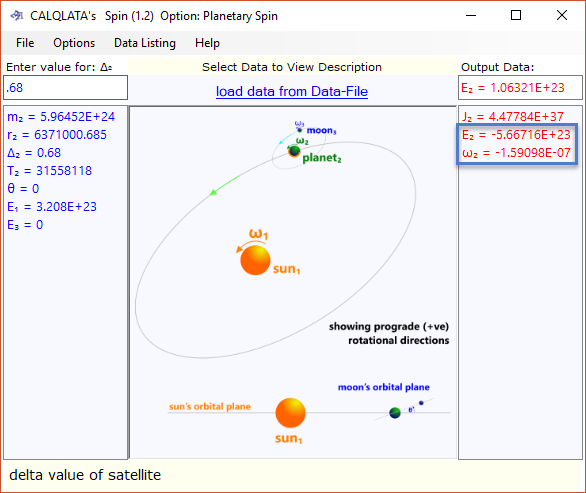The Earth's Magnetic Field (its cause)
{© 15/02/18}The following analysis, which was released by Keith Dixon-Roche (one of CalQlata's Contributors) on the 15th of February 2018, describes the cause of the earth's magnetic field and its mantle plumes.
Since completing spin theory, the generation of the earth's magnetic field and its mantle plumes has become obvious. This also applies to the magnetic field of all force-centre/satellites.
Earth and its Moon
Its lunar orbit is already tilting the earth's spin axis at a nominal angle of 24.3°
But conflicting forces induced by its stellar orbit are causing this tilt to fluctuate. Whilst this too will 'wobble' throughout an entire planetary orbit, it can be estimated mathematically.
There are two competing energies driving the spin in the earth's core and its mantle:
-E₀ (-2.14473244632E+23 J) is the sun's energy driving the core
E₁-E₃ (2.8770397039E+28 J) is the moon's energy driving the mantle (and core)
The polar moments of inertia:
Core: J = 3.49144112166E+34 kg.m²
Mantle: Jm = 1.07860404E+37 kg.m²
The angular velocities:
Core: ω = Sign(E₀) . √[2.|E₀|/J] = -3.50509019131E-06 ᶜ/s
Mantle: ωm = Sign(E₁-E₃) . √[2.|E₁-E₃|/Jm] = 7.3039350764E-05 ᶜ/s
The differential angular velocity:
δω = ω + ωm = 6.95342605725E-05 ᶜ/s
The angular tilt (α) between the two axes can be calculated using the following formula:
α = sign(|ω/ωm|) . ½.√[ Asin(|ω/ωm|) ] = 0.109553685228394 radians = 6.27696379369167° ©
α's positive value, together with the right-hand-rule provides the correct orientation for the earth's magnetic field.

The above figure is a nominal value and will vary as the gravitational forces of sun, the moon and the other planet's vary. It will also vary from North Pole to South Pole when the earths core is pulled off-centre by the opposing forces of our sun and our moon.
Earth With No Moon
If the earth loses its moon, it will also lose its tilt (but not its wobble) and E₃ will be 0 (zero)
The above formula then becomes:
E₂ = E₁ - Eₒ
In which;
E₁ = 3.208E+23 J
Eₒ = 2.14479E+23 J
E₂ = 1.06321E+23 J (Fig 1) as opposed to with its moon (2.87709E+28 J)
Reducing the earth's internal friction (and heat) and its magnetic field by a factor of ≈3E+05
With no moon, there would be insufficient energy to drive the continental plates and the magnetic field would reduce to almost nothing as there is unlikely to be sufficient internal heat to provide a molten outer core/inner mantle.
The earth would therefore have a similar internal composition to Venus (Δ = 0.68) and its resultant spin would look like the calculation in Fig 2
where; E₂ = E₁ - Eₒ = 3.208E+23 - 8.90599E+23 = -5.66716E+23 J

Moreover, with no moon, one earth day would be 10970.152 hours (457.1 current earth days) and the sun would rise in the West and set in the East
To conclude, the moon
1) generates the earth's internal heat, which causes continental drift,
2) generates the earth's magnetic field, which protects the earth's life from solar emissions
3) and tilts the earth relative to the sun, which gives us our seasons
i.e. with no moon the earth could no longer support life as we know it.
Magnetic Reversal
What is more worrying is that the spin induced in the earth by our moon and our sun will not be the cause of magnetic reversal unless the moon changes direction (highly unlikely) or the sun reverses its spin (even more unlikely). Something external to the earth (extraterrestrial) must therefore cause this to occur every million years or so.
Remember; The Milky Way is just a large solar system, it too will have orbiting comets and many of these could well be planet or even star-size. If one of these passes through our solar system it could well be responsible for flipping the earth and maybe causing damage to other nearby planets.
Further Reading
You will find further reading on this subject in reference publications(55)